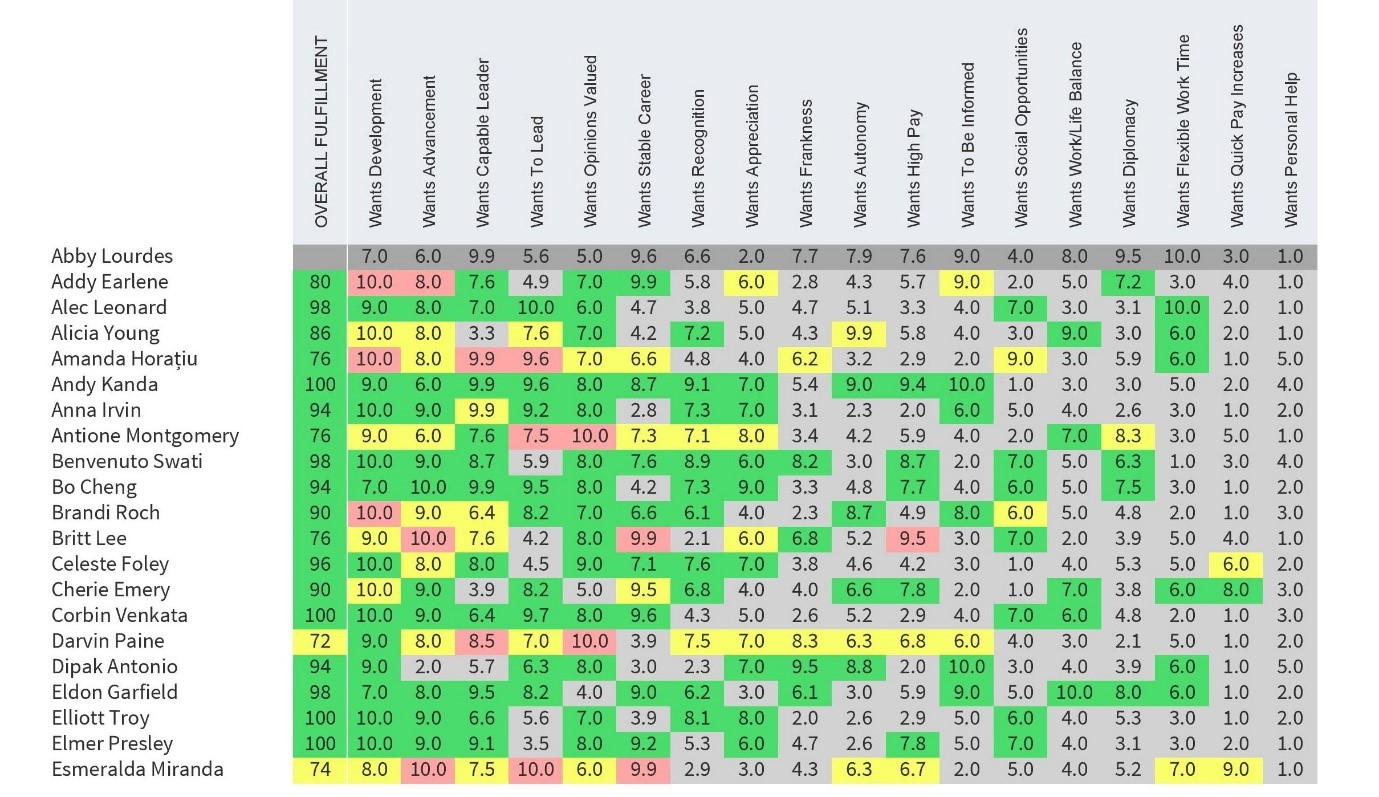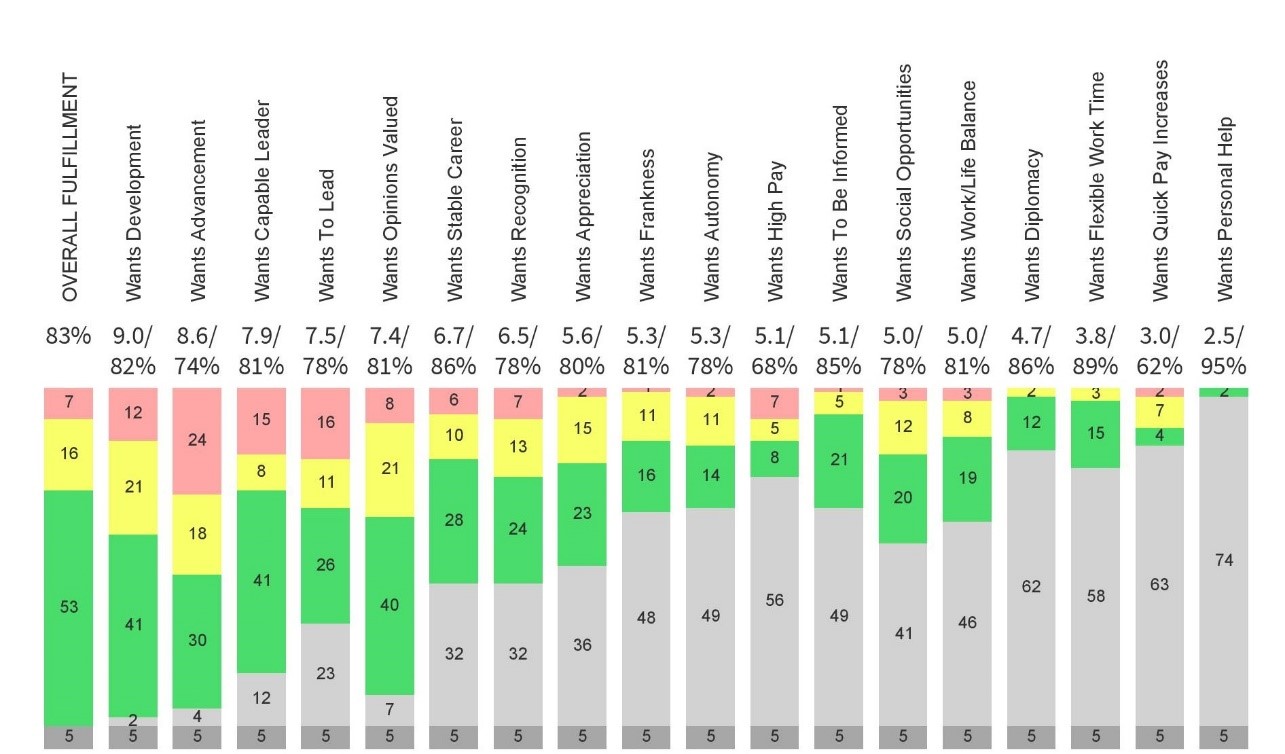Employee engagement is a personal matter for each individual.

Engaged employees who wholeheartedly give discretionary effort help the organisation succeed.
While employee engagement is now afforded greater focus, energy and resources by most organisations, traditional employee engagement surveys only measure group engagement issues, ignore the individual data that is crucial to engagement, and assumes only their managers are responsible for engagement.
To significantly increase employee engagement you need to understand the passions, motivations, and expectations of the individual, and use an approach which is based around engagement being a shared responsibility between the employee and the organisation.
Using objective data, we can map individual employee’s passions, motivations, expectations and the degree to which their expectations are perceived to be already being fulfilled, against eight essential Engagement metrics:
• Development • Remuneration • Authority • Social
• Appreciation • Communications • Personal • Work Life Balance

View of top 21 employees alphabetically sorted from a group of 81 employees in total
What does this tell us?
The graph above provides a clear picture of this group of individuals; overall fulfilment scores are predominantly high. This indicates that the majority of these employees feel that the employee expectations which are important to them as individuals are mostly being met.
Do Darvin and Esmerelda appear engaged in their day to day role? Their scores would indicate otherwise, and this will probably be apparent in some way in their behaviours and productivity levels.
Why may Darvin feel like his opinions are not being valued? What may be behind Esmerelda’s apparent lack of fulfilment in her advancement and desire to lead?
Amanda, Antoine and Britt look like it wouldn’t take much for their engagement levels to drop either, and there are some areas where various individuals have rated factors as very important (10’s) which are not being fulfilled and could cause some issues.
The key is to find out what is behind the data
Each of these people – and everyone else in the group – could all benefit from a positive 1-2-1 discussion with their manager to firstly to explore may be behind these scores and to see why they feel their individual expectations are not being fulfilled, and what could be done by their manager, the organisation and they themselves to improve this, and their engagement in their role.
We can also see from the number of high scores afforded across the first 5 expectations – the desire for Development, Advancement, a Capable Leader, To Lead, and to have Opinions Valued, that these seem to be the most often identified as being important to the majority, whereas Quick Pay Increases and Personal Help do not appear to be deemed as important to the individuals in the group.
Room for improvement
The yellow and red areas indicate those expectations that are not necessarily being fulfilled, and can provide a great basis for 2-way conversation firstly to explore may be behind these scores and then to discuss how both parties can improve the situation and benefit from greater engagement. There may be some personal circumstances which are influencing the scores. There could be some simple local solutions in the team which could be implemented, and individual’s feedback could also be useful in feeding into developing wider organisational plans and strategies.
This granular level of in-depth engagement analytics can develop your leaders’ capability to engage their teams and retain top talent. Being able to see how individuals’ values align with your organisation’s business objectives and goals can promote open and engaging discussions and make performance reviews comfortable and productive for everybody.
- Understand individual employee’s expectations and the degree to which there are met.
- Provide effective engagement intervention for each individual employee by targeting the factors that are important to each employee.
- Place employees in roles that are engaging.
- Identify how the organisation can help fulfil the employee’s expectations as well as what the employee needs to do.
Understand engagement and fulfilment levels across the business
As well as individual data, an Organisational view enables you to understand collective engagement and fulfilment levels across the business.

View of employee engagement expectations data from a group of 81 employees in total
Again, we can see clearly that whereas the overall fulfilment of the group of 81 employees is around 2/3rds satisfied, there remains 1 third of expectations unmet.
We can also see that ‘Wants Development’ is the highest placed expectation, and ‘Wants Opinions Valued’ is the most unmet of them all. The grey areas show where those expectations have not been ranked highly, and indicates that flexible work time, quick pay increases and personal help are of little value to this group of individuals.
Explore your data in many different ways
Interactive dashboards allow you to select groups to analyse by department, team, or manager using customisable tags and easily generate reports. A traffic light colour scheme easily identifies any hot spot areas to focus on.
Using advanced organisational analytics such as these for PEOPLE means you can measure, identify, develop, and improve across individuals, groups, teams, business areas and behaviours using global and individual data to support people plans, drive action, and to create a culture of engagement and high performance.
Visualise your Group Data
 This is a snapshot of the high-level Organisational Analytics data available just across Employee Engagement Expectations. You can also get data for your people and your organisation on:
This is a snapshot of the high-level Organisational Analytics data available just across Employee Engagement Expectations. You can also get data for your people and your organisation on:
- Senior and emerging leadership competency
- Culture of your organisation
- Collaboration and Team competencies
- Team Dynamics
- Emotional Intelligence competencies
- Remote Working competencies
How helpful would this data be for informing your people development plans, culture and engagement programmes and succession plans?
You can find out more about Organisational Analytics here. leaders skills and competencies
If you would like to discuss how Organisational Analytics can help support your business objectives and people plans please contact Pat Hutchinson: pat@quadrant1.com or on 07768 922244


